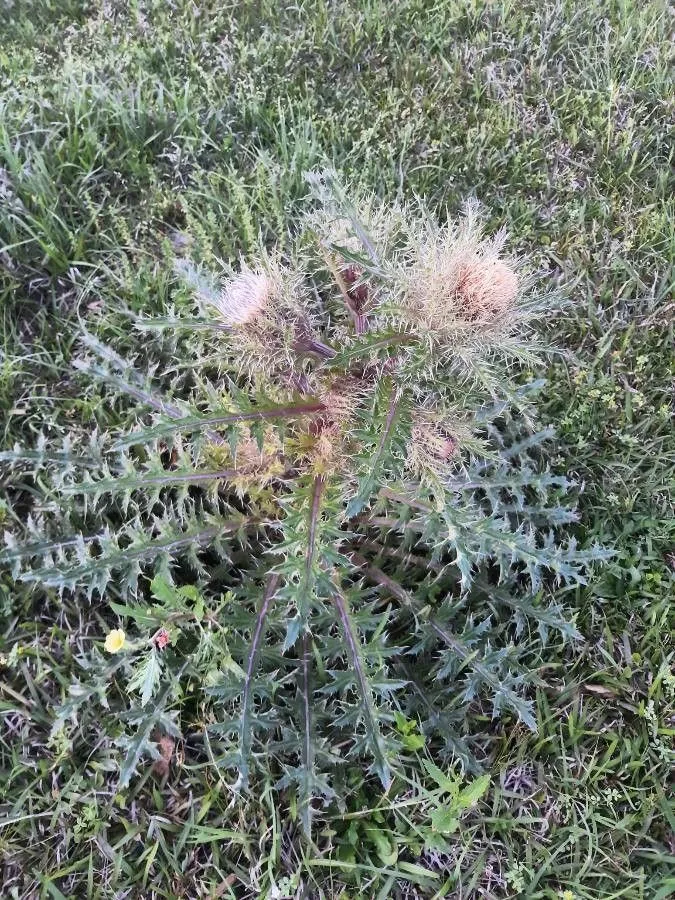
Author: Michx.
Bibliography: Fl. Bor.-Amer. 2: 90 (1803)
Year: 1803
Status: accepted
Rank: species
Genus: Cirsium
Vegetable: False
Observations: E. U.S.A. to Honduras, Bahamas
The horrid thistle, known scientifically as Cirsium horridulum, is a distinctive and fascinating plant species belonging to the Asteraceae family. This striking plant was described in 1803 by the botanist Michaux in his seminal work “Flora Boreali-Americana.”
Native to a broad geographical range, the horrid thistle is predominantly found in the eastern regions of the United States, extending as far south as Honduras, and even flourishing in the Bahamas. This widespread distribution indicates the plant’s adaptability to various environmental conditions, making it a resilient member of its ecosystem.
Characterized by its intimidating appearance, Cirsium horridulum lives up to its common name. The plant is known for its formidable thorns and spiny leaves that serve as a natural defense mechanism against herbivores. Despite its rough exterior, the horrid thistle plays an important ecological role, contributing to the biodiversity of the habitats it occupies. It provides nectar and pollen to a variety of pollinators, including bees and butterflies, which are crucial for the pollination of many other plant species.
The horrid thistle typically grows in open, sunny locations and is often found in disturbed areas such as roadsides, fields, and clearings. Its ability to thrive in such environments highlights its status as a pioneer species, often one of the first plants to colonize and stabilize soil in challenging conditions.
In terms of its physical description, Cirsium horridulum stands out with its robust, often multi-branched stems that can reach impressive heights. The plant’s flower heads are equally noteworthy, featuring a deep, vibrant purple hue that contrasts sharply with its otherwise harsh-looking structure. These flowers not only add to the plant’s unique aesthetic but also play a vital role in attracting pollinators.
In summary, the horrid thistle (Cirsium horridulum) is a noteworthy species within the Asteraceae family, remarkable for its ecological significance, adaptability, and unique morphology. Its presence from the eastern United States to Central America and the Bahamas underscores a versatile nature that has allowed it to endure and flourish in a variety of habitats.
Eng: bristly thistle, bull thistle, horrid thistle, yellow thistle
En: Horrid thistle, Bristly thistle, Bull thistle, Yellow thistle
Taken Jan 1, 1900 by EOL − Cooper, G.A. (cc-by-nc-sa)
Taken Apr 16, 2020 by Kendra Adams (cc-by-sa)
Taken Apr 9, 2021 by Eli Small (cc-by-sa)
Taken Apr 4, 2021 by Alexa Gucci (cc-by-sa)
Taken Mar 7, 2022 by Rick Snyder (cc-by-sa)
Taken Apr 1, 2021 by Johnnie Walters (cc-by-sa)
Taken Feb 11, 2020 by Billiot Alli (cc-by-sa)
Taken Apr 10, 2021 by Rosamund rosie (cc-by-sa)
Taken Jul 15, 2021 by Pedro Suárez (cc-by-sa)
Taken Apr 23, 2021 by Grayson Gregory (cc-by-sa)
Taken Apr 9, 2021 by Eli Small (cc-by-sa)
Taken Apr 2, 2020 by Alexandre Bessy (cc-by-sa)
Taken Apr 12, 2019 by Eli Small (cc-by-sa)
Taken Apr 25, 2021 by Eli Small (cc-by-sa)
Taken May 4, 2020 by gene jones (cc-by-sa)
Taken Dec 6, 2013 by EOL − Linda Jo Conn (cc-by-nc)
Taken Apr 9, 2021 by Eli Small (cc-by-sa)
Taken Apr 29, 2020 by Eli Small (cc-by-sa)
Taken Mar 8, 2014 by EOL − Matthew O’Donnell (cc-by-nc-sa)
Taken Mar 18, 2016 by EOL − Aaron Young (cc-by-nc)
Taken Apr 11, 2014 by EOL − Christopher Tracey (cc-by-nc-sa)
Taken Apr 20, 2014 by EOL − eustatic (cc-by-nc-sa)
Taken Apr 9, 2021 by Eli Small (cc-by-sa)
Taken Aug 17, 2010 by EOL − Jeffrey S. Pippen, http://www.duke.edu/~jspippen/nature.htm (cc-by-nc)
Taken Aug 17, 2010 by EOL − Jeffrey S. Pippen, http://www.duke.edu/~jspippen/nature.htm (cc-by-nc)
Taken Mar 22, 2012 by EOL − Michael J. Gras, M.Ed. (cc-by)
Taken Mar 22, 2012 by EOL − Michael J. Gras, M.Ed. (cc-by)
Taken Apr 20, 2014 by EOL − eustatic (cc-by-nc-sa)
© copyright of the Board of Trustees of the Royal Botanic Gardens, Kew.
© copyright of the Board of Trustees of the Royal Botanic Gardens, Kew.
© copyright of the Board of Trustees of the Royal Botanic Gardens, Kew.
Growth habit: Forb/herb
Family: Myrtaceae Author: (F.Muell.) K.D.Hill & L.A.S.Johnson Bibliography: Telopea 6: 402 (1995) Year: 1995 Status:…
Family: Rubiaceae Author: Pierre ex A.Froehner Bibliography: Notizbl. Bot. Gart. Berlin-Dahlem 1: 237 (1897) Year:…
Family: Sapindaceae Author: Koidz. Bibliography: J. Coll. Sci. Imp. Univ. Tokyo 32(1): 38 (1911) Year:…
Family: Asteraceae Author: A.Gray Bibliography: Pacif. Railr. Rep.: 107 (1857) Year: 1857 Status: accepted Rank:…
Family: Fabaceae Author: Medik. Bibliography: Vorles. Churpfälz. Phys.-Ökon. Ges. 2: 398 (1787) Year: 1787 Status:…
Family: Aspleniaceae Author: (Cav.) Alston Bibliography: Bull. Misc. Inform. Kew 1932: 309 (1932) Year: 1932…